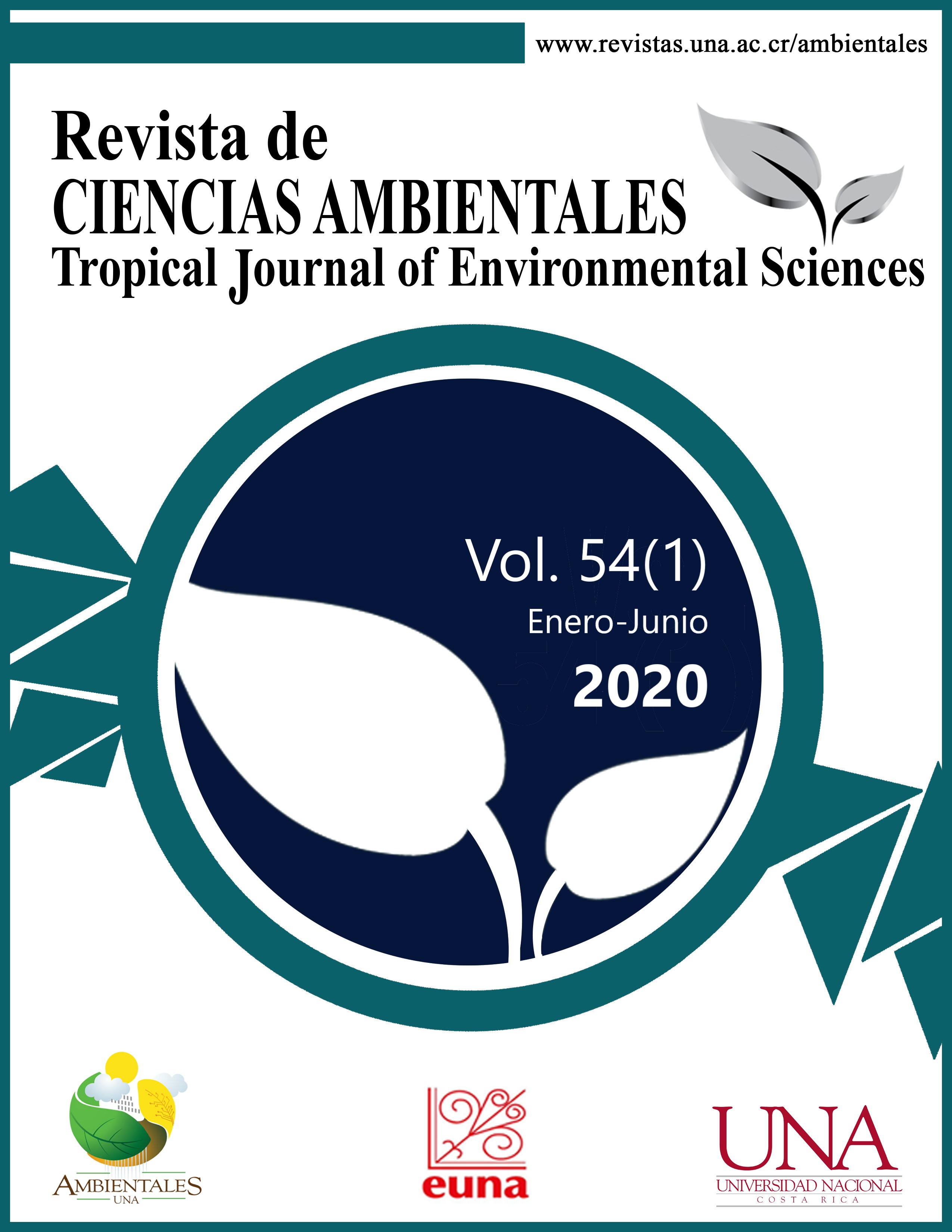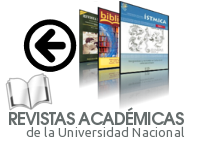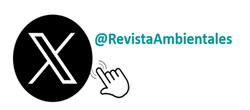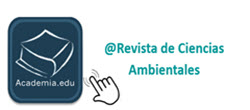Soil Conservation by Changing the Frequency of Tillage: A Case in Costa Rica
DOI:
https://doi.org/10.15359/rca.54-1.7Keywords:
agricultural machinery; conservation tillage; physical properties; soil degradation.Abstract
[Introduction:] In Costa Rica, horticultural producers till the soil every six months, using conventional systems that pulverize the arable layer and cause degradation. [Objectives:] The effect of different types of tillage was evaluated in order to recommend variations in the management of soil mechanization. [Methodology:] Tillage treatments were established for which zero (T1), conventional (T2) and reduced (T3) in a loamy-sandy soil (Fa). The organic matter content (MO), apparent density (Da), hydraulic conductivity (k), penetration resistance (RP) and moisture retention (RH) were determined before each treatment (T0) and after six months. Also, operation variables of the used tractor were measured. [Results:] The need to ballast the tractor to rotate the ground and have better efficiency was determined due to the skid of the front axle at T2 (-34.81%). T2 showed increases in MO (p <0.05), due to the short-term effect of the surface cut of the vegetation cover and Da increased (p <0.05) at 30-45 cm in T1, because there was no chisel plow pass. No treatment changed the condition of moderate k to 30 cm deep. T3, improved RP (p <0.05) up to 30 cm deep due to the chisel plow pass. HR did not change (p <0.05). [Conclusions:] Due to the inefficiency of operation and because there is no physical improvement of the soil in the short term, it is not necessary to till every six months, which would reduce the erosion rates of the area.
References
Alvarado, A. (2004). Maquinaria y mecanización agrícola. (S. Delome, Ed.) (Primera ed.). San José, Costa Rica: EUNED.
Álvarez, R., Mart, S. y Aires, B. (2006). ¿Afecta el sistema de labranza las propiedades físicas de los suelos de la Región Pampeana? Recuperado de http://www.ipni.net/ppiweb/iaarg.nsf/$webindex/ACDD9C4F17B4C5CE0325728E00689057/$file/Steinbach.pdf
Amezquita, E. (1996). Diseño y construcción de un microrelievímetro para evaluar la dinámica de la erosión en zonas de ladera. Cali, Colombia.
Arrazate-Oropeza, B., Gómez-Calderón, N. y Villagra-Mendoza, K. (2016). Comparación de patinaje bajo diferentes tipos de labranza de suelo. In XII Congreso Latinoamericano y del Caribe de Ingeniería Agrícola (p. 649). Bogotá, Colombia: Universidad Nacional de Colombia.
Báez, M. y Aguirre, J. F. (2011). Efecto de la labranza de conservación sobre las propiedades del suelo. Terra Latinoamericana, 29(2), 113–121. Recuperado de http://www.redalyc.org/pdf/573/57321257001.pdf
Bangita, B. y Rao, B. K. R. (2012). Impacts of compaction relief treatments on soil physical properties and performance of sugarcane (Saccharum spp.) under zonal tillage system. Geoderma, 189–190, 351–356. https://doi.org/10.1016/j.geoderma.2012.07.002
Ben, S., Gallali, T., Ben, N., Jemai, I. and Ben-Hammouda, M. (2012). Impact of three and seven years of no-tillage on the soil water storage, in the plant root zone, under a dry subhumid Tunisian climate. Soil and Tillage Research, 126, 26–33. https://doi.org/10.1016/j.still.2012.07.008
Castilla, F. (2013). Siembra directa. La elegida para conservar el suelo: una decisión agronómica que combina rotación de cultivos, fertilizantes y agricultura de precisión para aumentar la producción y preservar los recursos naturales. Revista de Investigaciones Agropecuarias, 39(2), 118–123.
Ceballos, D., Hernández, O. and Vélez, J. (2010). Efecto de la labranza sobre las propiedades físicas en un andisol del Departamento de Nariño. Revista de Agronomía, XXVII(1), 40–48. Retrieved from https://dialnet.unirioja.es/descarga/articulo/5104154.pdf
COMCURE. (2016). Generalidades de la Cuenca del Río Reventazón - Parismina. Recuperado de http://comcure.go.cr/la-cuenca/generalidades
FAO. (2009). Guía para la descripción de suelos. Organización de las Naciones Unidas para la Agricultura y la Alimentación, 100. Recuperado de http://www.fao.org/soils-2015/resources/fao-publications/news-detail/es/c/263275/
FAO y ITPS. (2015). Status of the World’s Soil Resources (SWSR) – Main Report. Rome, Italy. Recuperado de http://www.fao.org/3/a-i5199e.pdf
Gómez-Calderón. (2016). Fundamentos de maquinaria agrícola (Primera ed.). San José, Costa Rica: EUNED.
Gómez-Calderón, N., Solórzano-Quintana, M. y Villagra-Mendoza, K. (2017). Cuantificación de la erosión hídrica en función de diferentes técnicas de mecanización para minimizar la contaminación del agua por sedimentos en la parte alta de la Cuenca del Río Reventazón. RepositorioTEC. Recuperado de https://repositoriotec.tec.ac.cr/handle/2238/9164
Gómez-Calderón, N., Solorzano-Quintana, M. y Villagra-Mendoza, K. (2016). Cuantificación de la erosión hídrica en función de diferentes técnicas de mecanización para minimizar la contaminación del agua por sedimentos en la parte alta de la Cuenca del Río Reventazón. Informe final. Cartago, Costa Rica.
Gómez-Calderón, N., Villagra-Mendoza, K. y Rímolo-Donadio, R. (2015). Estudio de factibilidad de desarrollo de un sistema de monitoreo aéreo de baja altura para la agricultura en el control de la erosión. VIE.
Gómez-Calderón, N., Villagra-Mendoza, K. y Solórzano-Quintana, M. (2018). La labranza mecanizada y su impacto en la conservación del suelo (revisión literaria). Revista Tecnología en Marcha, 31(1), 170. https://doi.org/10.18845/tm.v31i1.3506
Gutiérrez-Rodríguez, F., González-Huerta, A., Pérez-López, D. D. J., Franco-Mora, O., Morales-Rosales, E. J., Saldívar-Iglesias, P. y Martínez-Rueda, C. G. (2012). Compactación inducida por el rodaje de tractores agrícolas en un vertisol. Compaction Induced by Breaking of Agricultural Tractors in Vertisol. Terra Latinoamericana, 30(1), 1–7.
Hillel, D. (1998). Environmental Soil Physics. Academic Press; USA.
Horne, R. y Hartge, K. H. (2016). Essential Soil Physics. (R. Horton, R. Horn, J. Bachmann, & S. Peth, Eds.) (First). Sttutgart, Germany: Schweizerbart Science Publishers. Recuperado de www.schweizerbart.com/9783510652884
IPCC. (2019). Climate Change and Land. Retrieved August 8, 2019, from https://www.ipcc.ch/report/srccl/
Kovalevski, E., García, F., Ferreras, L., Magra, G. y Besson, P. (2007). Indicadores de calidad física en suelo de la Región Pampeana Norte De Argentina Bajo Siembra Directa. CI Suelo, 25(2), 159–172.
Kroulík, M., Kvíz, Z., Kumhála, F., Hůla, J. y Loch, T. (2011). Procedures of soil farming allowing reduction of compaction. Precision Agriculture. https://doi.org/10.1007/s11119-010-9206-1
Lal, R. (2001). Soil Degradation by Erosion. Land Degradation and Development, 12, 519–539. https://doi.org/10.1002/ldr.472
Lal, R. and Shukla, M. K. (2005). Principles of Soil Physics. (I. Marcel Dekker, Ed.). New York, USA: Taylor & Francis e-Library.
Mehuys, G. R., Tiessen, K. H. D., Villatoro, M., Sancho, F. and Lobb, D. A. (2009). Erosión por labranza con arado de disco en suelos volcánicos de ladera en Costa Rica. Agronomía Costarricense, 33(2), 205–215.
Quintero, M. and Comerford, N. B. (2013). Effects of Conservation Tillage on Total and Aggregated Soil Organic Carbon in the Andes. Open Journal of Soil Science, 03(08), 361–373. https://doi.org/10.4236/ojss.2013.38042
Reichert, J. M., da Rosa, V. T., Vogelmann, E. S., da Rosa, D. P., Horn, R., Reinert, D. J. and Denardin, J. E. (2016). Conceptual framework for capacity and intensity physical soil properties affected by short and long-term (14 years) continuous no-tillage and controlled traffic. Soil and Tillage Research, 158, 123–136. https://doi.org/10.1016/j.still.2015.11.010
Reynolds, W. D., Drury, C. F., Yang, X. M. y Tan, C. S. (2008). Optimal soil physical quality inferred through structural regression and parameter interactions. Geoderma, 146(3–4), 466–474. https://doi.org/10.1016/j.geoderma.2008.06.017
Rivas, E., Velásquez, E. y Tenías, J. (2004). Efecto de sistemas de preparación de suelos sobre algunas propiedades físicas del suelo y biométricas en yuca (Manihot esculenta Crantz) en Llanos Altos de Monagas. Revista Científica UDO Agrícola, 4(1), 36–41. Recuperado de https://dialnet.unirioja.es/descarga/articulo/2221553.pdf
RStudio. (2018). R Studio. Boston, MA: The R Foundation for Statistical Computing. Recuperado de http://www.rstudio.org/
Salem, H. M., Valero, C., Muñoz, M. Á., Rodríguez, M. G. y Silva, L. L. (2015). Short-term effects of four tillage practices on soil physical properties, soil water potential, and maize yield. Geoderma, 237-238(Enero), 60-70. https://doi.org/10.1016/j.geoderma.2014.08.014
USDA. (2014). Soil Survey Field and Laboratory Methods Manual. Soil Survey Investigations Report N.° 51. Version 2.0. R. Burt and Soil Survey Staff.
Vignola, R., McDaniels, T. L. and Scholz, R. W. (2013). Governance structures for ecosystem-based adaptation: Using policy-network analysis to identify key organizations for bridging information across scales and policy areas. Environmental Science & Policy, 31, 71–84. https://doi.org/10.1016/j.envsci.2013.03.004
Villalobos-Araya, M., Guzmán-Arias, I. y Zúñiga-Pereira, C. (2009). Evaluación de tres tipos de labranza en el cultivo de la papa (Solannum tuberosum). Tecnología En Marcha, 22, 40–50. Recuperado de https://revistas.tec.ac.cr/index.php/tec_marcha/article/view/115
Xue, J., Zhao, X., Dikgwatlhe, S. B., Chen, F. and Zhang, H. (2013). Advances in effects of conservation tillage on soil organic carbon and nitrogen. Shengtai Xuebao/ Acta Ecológica Sinica, 33(19), 6006–6013. https://doi.org/10.5846/stxb201305121021
Downloads
Published
How to Cite
Issue
Section
License

This work is licensed under a Creative Commons Attribution-NonCommercial-ShareAlike 4.0 International License.



















